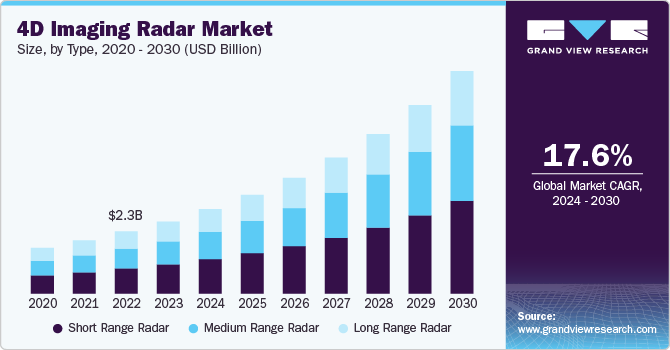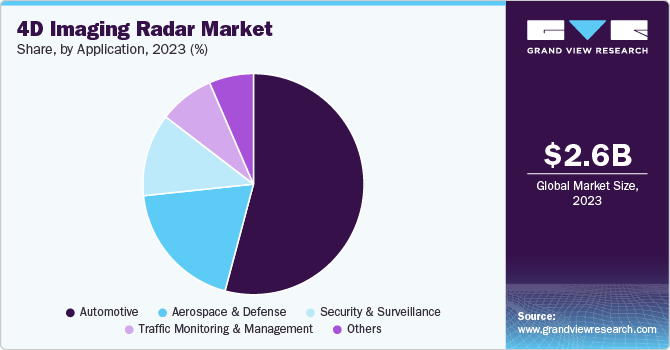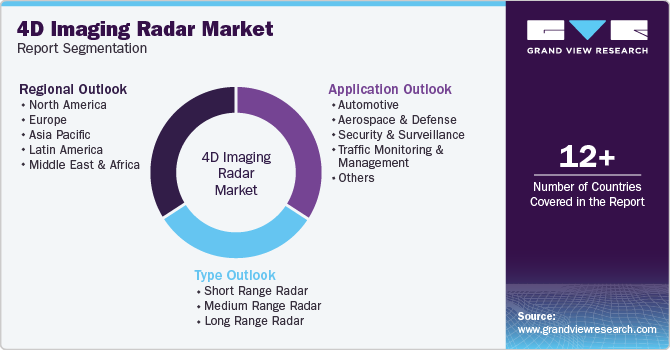
4D Imaging Radar Market Size, Share & Trends Analysis Report By Type (Short, Medium, Long), By Application (Automotive, Aerospace & Defense, Security & Surveillance, Traffic Monitoring & Management), By Region, And Segment Forecasts, 2024 - 2030
- Report ID: GVR-4-68040-475-3
- Number of Report Pages: 130
- Format: PDF
- Historical Range: 2018 - 2023
- Forecast Period: 2024 - 2030
- Industry: Technology
4D Imaging Radar Market Size & Trends
The global 4D imaging radar market size was estimated at USD 2.65 billion in 2023 and is expected to grow at a CAGR of 17.6% from 2024 to 2030.The growing adoption of autonomous vehicles, where 4D imaging radar plays a critical role in enhancing safety and navigation is a major factor contributing to the growth of the market. These systems offer precise detection and tracking of objects, even in adverse weather or poor visibility, making them essential for the development of self-driving cars. The automotive industry's push towards higher levels of vehicle autonomy, from Advanced Driver Assistance Systems (ADAS) to fully autonomous driving, is fueling the demand for more sophisticated radar technologies, thereby contributing to the growth of the market.

The rising use of drones and unmanned aerial vehicles (UAVs) is another significant trend contributing to the growth of the 4D imaging radar market. Drones are increasingly used in industries like agriculture, logistics, and defense, where radar technology helps improve navigation and obstacle avoidance. Unlike traditional sensors, 4D imaging radar provides detailed real-time data, ensuring that drones can operate autonomously in challenging environments. As drone applications continue to expand, particularly in delivery services and industrial inspections, the need for more advanced radar solutions will rise.
Industrial automation and robotics are also contributing to the growing demand for 4D imaging radar. Factories and warehouses are integrating autonomous robots to optimize operations, and radar systems help these robots move safely in complex environments. By enabling robots to detect and avoid obstacles, 4D imaging radar enhances operational efficiency and safety, especially in environments where traditional sensors may struggle. The shift towards smart manufacturing and the rise of Industry 4.0 is expected to further accelerate the adoption of this technology in the industrial sector.
In the security and surveillance domain, 4D imaging radar is gaining traction due to its ability to provide accurate detection in all weather conditions. Traditional camera-based systems face challenges in fog, rain, or low light, but radar technology can function reliably in such conditions. This makes it ideal for applications in border security, critical infrastructure protection, and urban surveillance. As concerns around public safety and security continue to grow, more governments and organizations are expected to invest in radar-based systems to enhance monitoring and threat detection.
Advancements in healthcare are emerging as a new frontier for 4D imaging radar. The technology’s ability to monitor movement and vital signs without physical contact is becoming increasingly important in-patient care, particularly for elderly and critical patients. Radar-based systems can track heart rate, breathing, and even detect falls, offering a non-invasive solution for remote health monitoring. As healthcare moves towards more patient-centric and technology-driven models, the integration of 4D radar in medical devices is likely to become a key growth area in the coming years.
Type Insights
Based on type, the short range radar segment led the market and accounted for 40.5% of the global revenue in 2023. Short-range radar is gaining significant traction, especially in automotive applications, where it plays a vital role in Advanced Driver Assistance Systems (ADAS) for features like parking assistance and blind spot detection. Its ability to accurately detect objects within close proximity makes it ideal for enhancing vehicle safety in urban and congested environments. Additionally, the growing use of short-range radar in consumer electronics, such as smart home devices and gesture recognition systems, is expanding its market potential. The compact size and low power consumption of short-range radar also make it suitable for drones and robotics, where space and energy efficiency are critical.
The medium range radar segment is expected to register significant growth from 2024 to 2030. Medium-range radar is becoming increasingly popular in sectors requiring broader spatial coverage, particularly in automotive applications like adaptive cruise control and collision avoidance systems. Its ability to detect objects at mid-range distances provides crucial data for vehicles traveling at higher speeds, enhancing both safety and navigation. Beyond automotive, medium-range radar is also being integrated into industrial automation systems for monitoring larger areas and improving operational efficiency in warehouses and factories. Additionally, in the defense and security sectors, medium-range radar is used for perimeter surveillance and threat detection, offering reliable performance in diverse weather conditions.
Application Insights
The automotive segment accounted for the largest market revenue share in 2023. 4D imaging radar is transforming vehicle safety and autonomy, with both short-range and medium-range radar playing key roles. Short-range radar is primarily used for close-proximity applications, such as parking assistance and blind spot monitoring, where precise object detection is critical for preventing collisions. Meanwhile, medium-range radar is essential for higher-speed functions like adaptive cruise control and collision avoidance, offering enhanced situational awareness over longer distances. As automakers push towards more advanced driver assistance systems (ADAS) and autonomous vehicles, the integration of both radar types ensures comprehensive coverage for vehicle safety.

The traffic monitoring & management segment is expected to grow significantly from 2024 to 2030. In traffic monitoring and management, short-range and medium-range radar are becoming vital tools for improving urban mobility and road safety. Short-range radar is used in smart intersections and traffic systems to monitor vehicle movement and pedestrian behavior in densely populated areas, ensuring efficient traffic flow and reducing accidents. On the other hand, medium-range radar provides broader coverage, helping authorities manage traffic congestion and detect speeding vehicles across highways and larger roads. The technology’s ability to function in various weather conditions makes it ideal for real-time traffic management, even in challenging environments.
Regional Insights
North America 4D imaging radar market is poised for significant growth from 2024 to 2030. In North America, the market is being driven by strong investments in autonomous driving technology and advanced driver assistance systems (ADAS). The region’s automotive industry is rapidly integrating radar solutions to enhance vehicle safety and meet stringent regulatory standards. Additionally, the expansion of smart city initiatives across North America is fueling demand for 4D imaging radar in traffic monitoring and management systems. The technology’s ability to function in diverse weather conditions makes it particularly valuable in this region, where varying climates present operational challenges.
U.S. 4D Imaging Radar Market Trends
The U.S. 4D imaging radar market is anticipated to register a significant growth from 2024 to 2030. The U.S. is a prominent market for 4D imaging radar, particularly in the automotive sector, where manufacturers are pushing the envelope on autonomous driving technologies. Regulatory support and consumer demand for enhanced safety features are driving widespread adoption of radar systems in vehicles. The defense sector also plays a crucial role, as radar is used extensively in surveillance, border security, and military applications.
Europe 4D Imaging Radar Market Trends
The Europe 4D Imaging Radar Marketis poised for significant growth from 2024 to 2030. In Europe, the market is benefiting from the region’s emphasis on safety and sustainability in transportation. The European Union’s regulations on vehicle safety standards are driving the integration of radar in advanced driver assistance systems (ADAS), especially as the region transitions toward electric and autonomous vehicles. Europe is also investing heavily in smart city projects, where radar plays a key role in traffic management and reducing road congestion. Additionally, the technology is gaining traction in the defense and aerospace sectors for surveillance and border protection.
Asia Pacific 4D Imaging Radar Market Trends:
The Asia Pacific 4D Imaging Radar market is poised for significant growth from 2024 to 2030. The Asia Pacific region is emerging as a major growth area for the 4D imaging radar market, largely due to the rapid adoption of automotive technologies in countries like China, Japan, and South Korea. The region’s robust manufacturing sector, combined with increasing investments in autonomous driving, is boosting the demand for radar solutions in vehicles. Governments across Asia Pacific are also implementing smart city projects to tackle urban challenges, driving the need for advanced traffic monitoring systems that leverage 4D radar.
Key 4D Imaging Radar Company Insights
As the demand for vehicle safety and automation increases, companies are investing heavily in R&D to enhance their product offerings. Additionally, regulatory pressures and consumer demand for safety features are driving market growth, creating opportunities for established companies and new entrants alike. The competitive landscape of the market is characterized by rapid technological advancements, strategic partnerships, and collaborations among key players.
For instance, in May 2023, NXP Semiconductors N.V. announced that NIO Inc. utilized its advanced automotive radar technology, including a groundbreaking 4D imaging radar solution. This technology significantly enhanced front radar performance, allowing vehicles to detect and classify objects, such as other vehicles and pedestrians, up to 300 meters away in various driving scenarios. NXP's imaging radar expanded traditional capabilities by measuring direction, angle of arrival, and elevation, which improved environmental mapping and object detection under diverse weather and lighting conditions. This innovation was crucial for advancing road safety and enabling features for autonomous driving.
Key 4D Imaging Radar Companies:
The following are the leading companies in the 4D imaging radar market. These companies collectively hold the largest market share and dictate industry trends.
- Robert Bosch GmbH.
- ZF Friedrichshafen AG
- Arbe
- Aptiv.
- Renesas Electronics Corporation.
- Continental AG
- Zadar Labs, Inc.
- Huawei Technologies Co., Ltd.
- RadSee
- Smartmicro.
4D Imaging Radar Market Report Scope
|
Report Attribute |
Details |
|
Market size value in 2024 |
USD 3.10 billion |
|
Revenue forecast in 2030 |
USD 8.17 billion |
|
Growth rate |
CAGR of 17.6% from 2024 to 2030 |
|
Actual data |
2018 - 2023 |
|
Forecast period |
2024 - 2030 |
|
Quantitative units |
Revenue in USD billion and CAGR from 2024 to 2030 |
|
Report coverage |
Revenue forecast, company market share, competitive landscape, growth factors, and trends |
|
Segments covered |
Type, application, region |
|
Regional scope |
North America; Europe; Asia Pacific; Latin America; MEA |
|
Country scope |
U.S.; Canada; Mexico; Germany; UK; France; China; India; Japan; South Korea; Australia; Brazil; Kingdom of Saudi Arabia (KSA); UAE; South Africa |
|
Key companies profiled |
Robert Bosch GmbH.; ZF Friedrichshafen AG; Arbe; Aptiv.; Renesas Electronics Corporation.; Continental AG; Zadar Labs, Inc.; Huawei Technologies Co., Ltd.; RadSee; Smartmicro |
|
Customization scope |
Free report customization (equivalent to up to 8 analysts working days) with purchase. Addition or alteration to country, regional & segment scope |
|
Pricing and purchase options |
Avail customized purchase options to meet your exact research needs. Explore purchase options |
Global 4D Imaging Radar Market Report Segmentation
The report forecasts revenue growth at global, regional, and country levels and provides an analysis of the latest industry trends in each of the sub-segments from 2018 to 2030. For the purpose of this study, Grand View Research has segmented the global 4D imaging radar market based on type, application, and region.

-
Type Outlook (Revenue, USD Billion, 2018 - 2030)
-
Short Range Radar
-
Medium Range Radar
-
Long Range Radar
-
-
Application Outlook (Revenue, USD Billion, 2018 - 2030)
-
Automotive
-
Aerospace & Defense
-
Security & Surveillance
-
Traffic Monitoring & Management
-
Others
-
-
Regional Outlook (Revenue, USD Billion, 2018 - 2030)
-
North America
-
U.S.
-
Canada
-
Mexico
-
-
Europe
-
Germany
-
UK
-
France
-
-
Asia Pacific
-
China
-
India
-
Japan
-
South Korea
-
Australia
-
-
Latin America
-
Brazil
-
-
Middle East & Africa (MEA)
-
UAE
-
Kingdom of Saudi Arabia (KSA)
-
South Africa
-
-
Frequently Asked Questions About This Report
b. The global 4D imaging radar market size was estimated at USD 2.65 billion in 2023 and is expected to reach USD 3.10 billion in 2024.
b. The global 4D imaging radar market is expected to grow at a compound annual growth rate of 17.6% from 2024 to 2030 to reach USD 8.17 billion by 2030.
b. North America dominated the 4D imaging radar market with a share of 35.26% in 2023. The growing adoption of autonomous vehicles, where 4D imaging radar plays a critical role in enhancing safety and navigation, is a major factor contributing to the growth of the market.
b. Some of the key players operating in the 4D imaging radar market include Robert Bosch GmbH., ZF Friedrichshafen AG, Arbe, Aptiv., Renesas Electronics Corporation., Continental AG, Zadar Labs, Inc., Huawei Technologies Co., Ltd., RadSee, and Smartmicro.
b. Key factors driving the 4D imaging radar market include the increasing demand for Advanced Driver Assistance Systems (ADAS), autonomous vehicles, and enhanced safety features in automotive applications.
We are committed towards customer satisfaction, and quality service.
"The quality of research they have done for us has been excellent."




